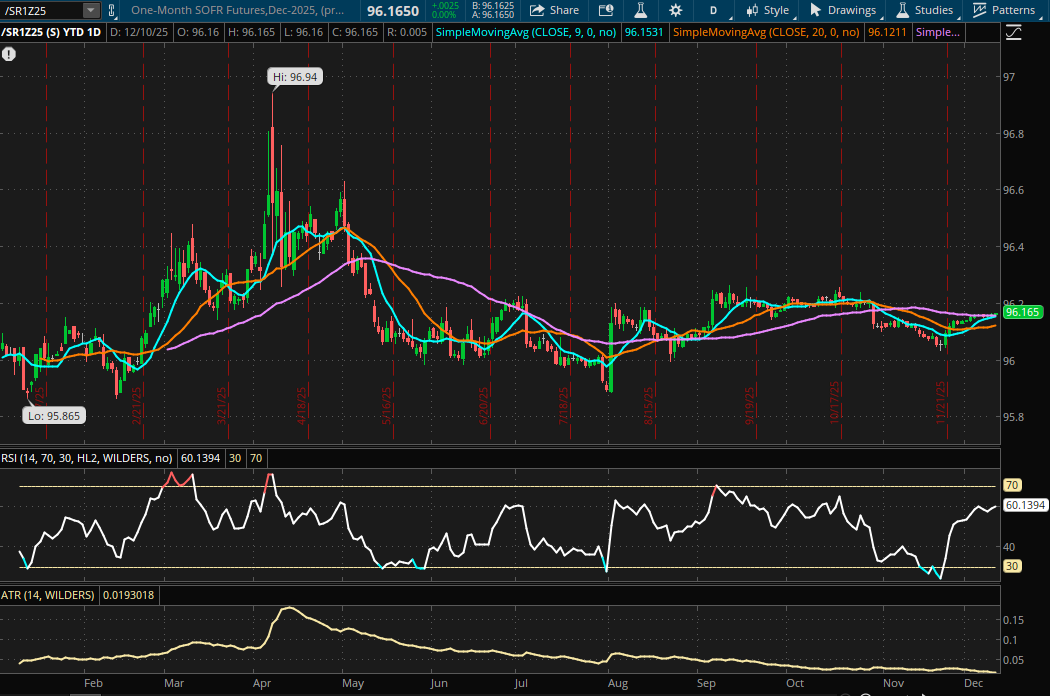Looking to the Futures
Short Term Rates Near Three-Year Lows Ahead of Fed Meeting

The Royal Bank of Australia kept its benchmark rate unchanged at 3.60% on Monday. The Bank of Canada will release their overnight rate today, followed by the Fed. Then the Swiss National Bank will make an announcement in the wee hours tomorrow. But wait! There’s more! Next Thursday will see releases from the Bank of England, the European Central Bank and the Bank of Japan.
Focusing on the domestic news, today’s FOMC announcement will be accompanied by the Summary of Economic Projections. The Summary contains the dot plot, which presents the forecasts of each member of the committee for the Fed funds rate plus various economic data including GDP growth and employment. Ahead of today’s announcement, the CME FedWatch Tool currently shows the chance of a 25-basis-point cut at around 90%.
While data has been delayed by the government shutdown, recent information on unemployment and inflation is sending mixed messages. ADP reported that private employment dropped by 32,000 in November, versus expectations of an increase of 5,000 jobs. On the other hand, initial unemployment claims for the last week of November came in at 191,000, lower than the forecast of 219,000, while continuing claims were little changed. September’s personal consumption expenditures price index (PCE) numbers met expectations, increasing 0.2% month-over-month and 2.8% versus last year. The Fed references the PCE in determining inflation trends versus its 2% target. The regular headline consumer price index data has been delayed due to the government shutdown, with the release scheduled for next Thursday.
Short-term interest rates align with the interest rate futures market. Last week, the yield on the 13-week T-bill (IRX:CGI) dropped below 3.6% for the first time since October 2022. The prior low was in the middle of the Fed’s cycle of interest rate hikes, and it topped out at 5.35% in October 2023. The 2-year yield (DGS2:FRED) is also trending lower, but not as sharply or steadily as the shortest-maturity yield. The current yield of 3.56% is in line with its 3-month average and slightly below its average for the year. The 2-year yield is also the lowest out of all the maturities, possibly indicating that treasury traders believe more Fed cuts are coming. While short-term rates are largely dictated by the Fed, rates on longer-dated treasuries are more tethered to expectations for the economy and the future path of debt issuance. Further out on the curve, the 5-year yield is around its 6-month average at 3.77% while the 10-year yield (TNX:CGI) paints a similar picture, currently yielding 4.17%. At the long end of the curve, the 30-year yield (TYX:CGI) is running at 4.8%, above its average for the year.
Technicals
The chart on the December 2025 1-Month SOFR futures contract (/SR1Z25) reached a high in April followed by a significant moderation. It has spent the last six months between 96 and 96.2 with few exceptions. Despite that narrow range, the 14-day RSI has moved between overbought and oversold levels a few times since the trading range narrowed. The 14-day Average True Range is narrowing as the contract nears expiration, which means that smaller moves can make big impacts on the RSI.

9-Day SMA 96.1531
20-Day SMA 96.1211
50-Day SMA 96.1563
14-Day RSI 60.14%
Contract Specifications

Economic Calendar
EIA Crude Oil Inventories 10:30 AM ET
Employment Cost Index 8:30 AM ET
FOMC Rate Decision 2:00 PM ET
MBA Mortgage Applications Index 7:00 AM ET
Treasury Budget 2:00 PM ET
New Products
New futures products are available to trade with a futures-approved account on all thinkorswim platforms:
- Ripple (/XRP)
- Micro Ripple (/MXP)
- Micro Corn (/MZC)
- Micro Wheat (/MZW)
- Micro Soybean (/MZS)
- Micro Soybean Oil Futures (/MZL)
- Micro Soybean Meal Futures (/MZM)
- 1 OZ Gold (/1OZ)
- Solana (/SOL)
- Micro Solana (/MSL)
Visit the Schwab.com Futures Markets page to explore the wide variety of futures contracts available for trading through Charles Schwab Futures and Forex LLC.